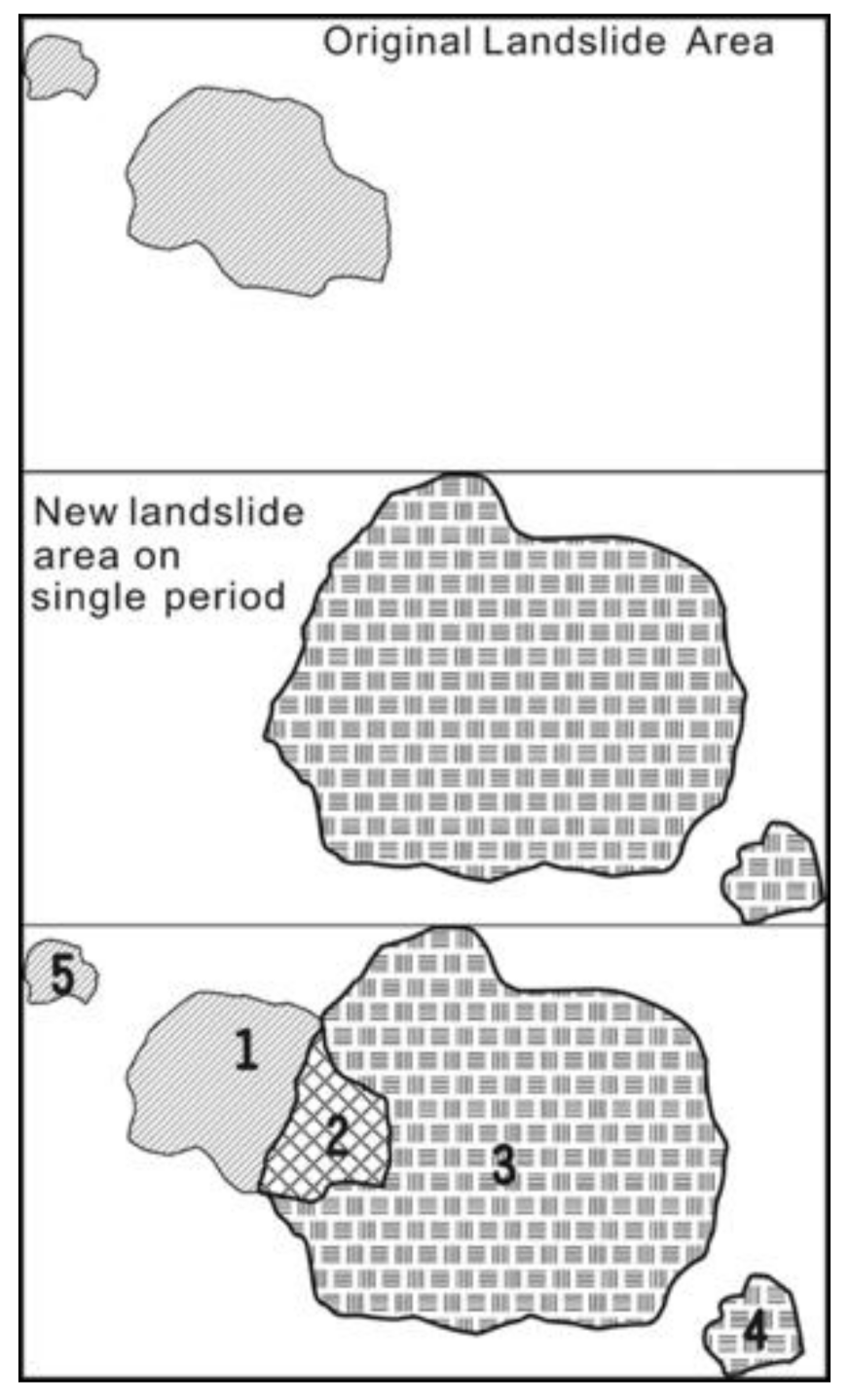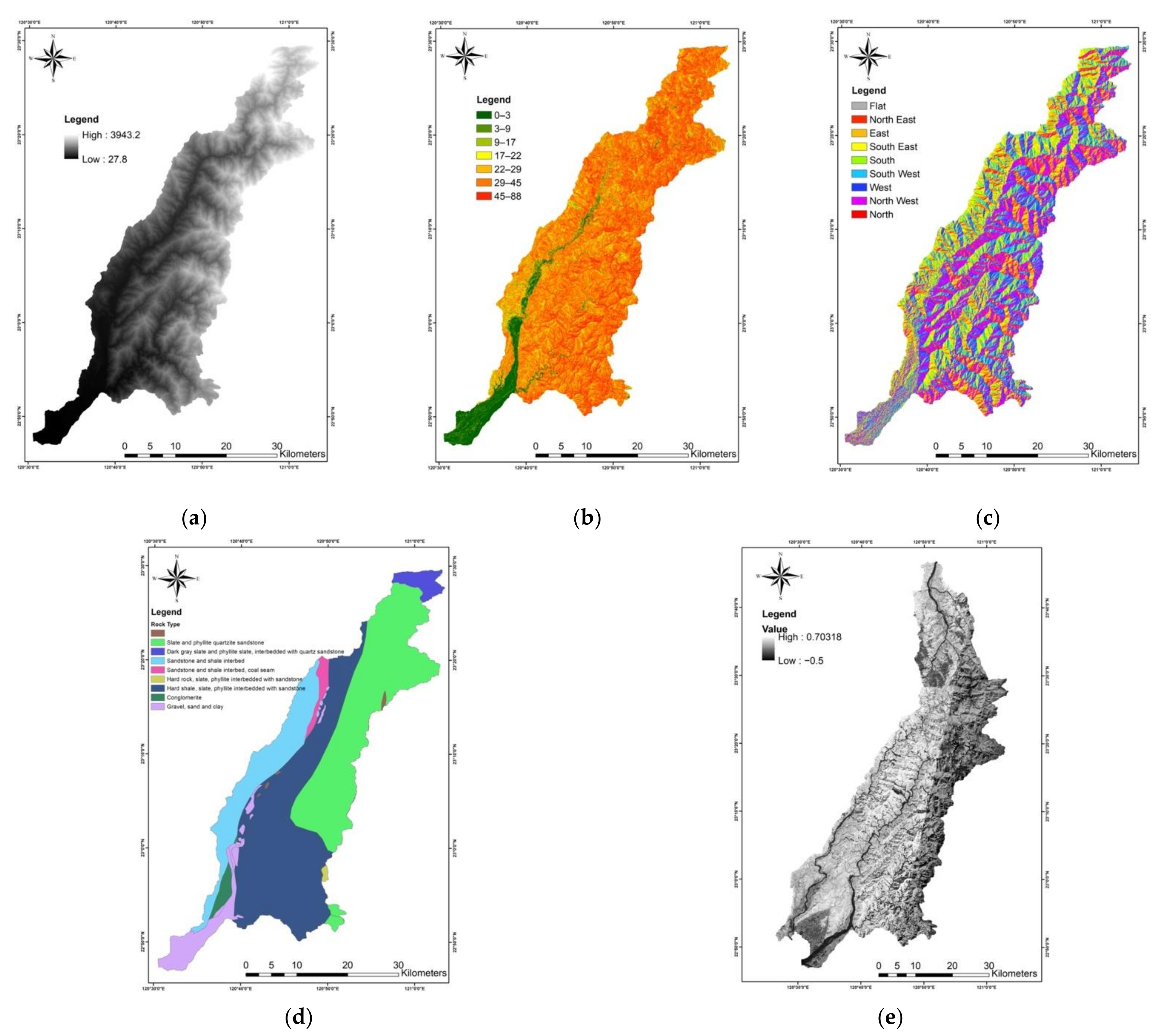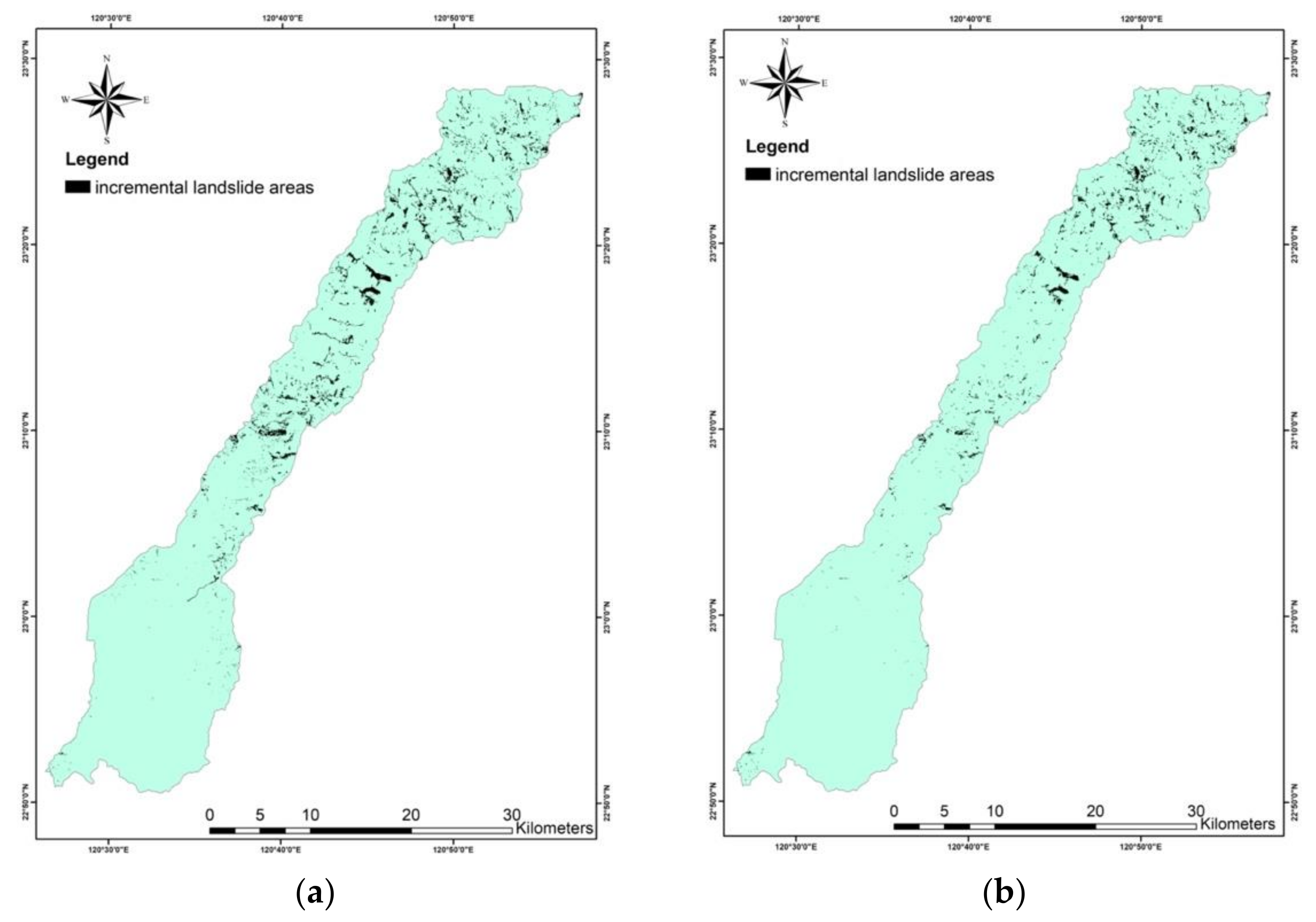The Effect of Temporal Characteristics on Developing a Practical Rainfall-Induced Landslide Potential Evaluation Model Using Random Forest Method
Abstract
:1. Introduction
2. Study Areas and Environmental Factor Database
2.1. Study Areas
2.2. Slope Units
2.3. Environmental Database and Model Factors
3. Development of Landslide Potential Evaluation Model
4. Model Performance Evaluation for Individual Rainfall Events
5. Conclusions
- According to the analysis results, adding temporal characteristics had significantly improved the performance of landslide potential prediction by the proposed random forest model.
- The contribution of antecedent landslide ratios was significant in improving the model performance. The performance improvement of the model indicated that the time-dependent factors should be taken into consideration, in terms of a series of inputs within a period, such as the five years in this study.
- The results of better model performance had shown the significance of cumulative change with time. Therefore, a relevant factor, e.g., the antecedent landslide ratios of the past five years, to describe the time effects was significant in landslide potential evaluation.
- The trained model by considering annual temporal factors provided an angle to estimate the landslide potential in event-type disaster responses.
Author Contributions
Funding
Institutional Review Board Statement
Informed Consent Statement
Data Availability Statement
Acknowledgments
Conflicts of Interest
References
- Lei, T.C.; Huang, Y.M.; Lee, B.J.; Hsieh, M.H.; Lin, K.T. Development of an empirical model for rainfall-induced hillside vulnerability assessment: A case study on Chen-Yu-Lan watershed, Nantou, Taiwan. Nat. Hazards 2014, 74, 341–373. [Google Scholar] [CrossRef]
- Huang, Y.M.; Lei, T.C.; Lee, B.J.; Hsieh, M.H. Landslide Potential Evaluation Using Fragility Curve Model. In Landslides—Investigation and Monitoring, 1st ed.; Ray, R., Lazzari, M., Eds.; IntechOpen: London, UK, 2019. [Google Scholar] [CrossRef] [Green Version]
- Chang, F.J.; Lee, S.P. A study of the intelligent control theory for the debris flow warning system. In Proceedings of the First International Conference on Debris Flow Hazards Mitigation, San Francisco, CA, USA, 7–9 August; Philip Chen, C.L., Ed.; American Society of Civil Engineers: Reston, VA, USA, 1997; pp. 109–123. [Google Scholar]
- Lee, C.T.; Cheng, C.T.; Liao, C.W.; Tsai, Y.B. Site classification of Taiwan free-field strong-motion stations. Bull. Seismol. Soc. Am. 2001, 91, 1283–1297. [Google Scholar]
- Lee, S.; Choi, J. Landslide susceptibility mapping using GIS and the weight-of-evidence model. Int. J. Geogr. Inf. Sci. 2004, 18, 789–814. [Google Scholar]
- Ermini, L.; Catani, F.; Casagli, N. Artificial neural networks applied to landslide susceptibility assessment. Geomorphology 2005, 66, 327–343. [Google Scholar]
- Wang, H.B.; Sassa, K. Rainfall-induced landslide hazard assessment using artificial neural networks. Earth Surf. Proc. Land. 2006, 31, 235–247. [Google Scholar]
- Tan, L.; Guo, J.; Mohanarajah, S.; Zhou, K. Can we detect trends in natural disaster management with artificial intelligence? A review of modeling practices. Nat. Hazards 2021, 107, 2389–2417. [Google Scholar] [CrossRef]
- Dikshit, A.; Sarkar, R.; Pradhan, B.; Segoni, S.; Alamri, A.M. Rainfall Induced Landslide Studies in Indian Himalayan Region: A Critical Review. Appl. Sci. 2020, 10, 2466. [Google Scholar]
- Park, S.; Kim, J. Landslide Susceptibility Mapping Based on Random Forest and Boosted Regression Tree Models, and a Comparison of Their Performance. Appl. Sci. 2019, 9, 942. [Google Scholar] [CrossRef] [Green Version]
- Pourghasemi, H.R.; Kerle, N. Random forests and evidential belief function-based landslide susceptibility assessment in Western Mazandaran Province, Iran. Environ. Earth Sci. 2016, 75, 1–17. [Google Scholar]
- Youssef, A.M.; Pourghasemi, H.R.; Pourtaghi, Z.S.; Al-Katheeri, M.M. Landslide susceptibility mapping using random forest, boosted regression tree, classification and regression tree, and general linear models and comparison of their performance at Wadi Tayyah Basin, Asir Region, Saudi Arabia. Landslides 2015, 13, 1–18. [Google Scholar]
- Di Napoli, M.; Carotenuto, F.; Cevasco, A.; Confuorto, P.; Di Martire, D.; Firpo, M.; Pepe, G.; Raso, E.; Calcaterra, D. Machine learning ensemble modelling as a tool to improve landslide susceptibility mapping reliability. Landslides 2020, 17, 1897–1914. [Google Scholar] [CrossRef]
- Catani, F.; Lagomarsino, D.; Segoni, S.; Tofani, V. Landslide susceptibility estimation by random forests technique: Sensitivity and scaling issues. Nat. Hazards Earth Syst. Sci. 2013, 13, 2815–2831. [Google Scholar] [CrossRef] [Green Version]
- Chen, W.; Xie, X.; Wang, J.; Pradhan, B.; Hong, H.; Bui, D.T.; Duan, Z.; Ma, J. A comparative study of logistic model tree, random forest, and classification and regression tree models for spatial prediction of landslide susceptibility. CATENA 2017, 151, 147–160. [Google Scholar]
- Crichton, D. The risk triangle. In Natural Disaster Management; Ingleton, J., Ed.; Tudor Rose: London, UK, 1999; pp. 102–103. [Google Scholar]
- Lee, C.Y.; Lee, B.J.; Huang, Y.M.; Lei, T.C.; Hsieh, M.H.; Wang, H.P.; Fang, Y.M.; Yin, H.Y. Risk Assessment of Landslide by using Fragility Curves—A Case Study in Shenmu, Taiwan. In Geotechnical Hazard Mitigations: Experiment, Theory and Practice, Proceedings of the 5th International Conference on Geotechnical Engineering for Disaster Mitigation and Rehabilitation; Taipei, Taiwan, 13–14 September 2017, Lin, M.L., Ed.; Chinese Taipei Geotechnical Society and Ainosco Press Taiwan: Taipei, Taiwan, 2017; pp. 137–148. [Google Scholar] [CrossRef]
- Segoni, S.; Piciullo, L.; Gariano, S.L. A review of the recent literature on rainfall thresholds for landslide occurrence. Landslides 2018, 15, 1483–1501. [Google Scholar]
- Gariano, S.L.; Melillo, M.; Peruccacci, S.; Brunetti, M.T. How much does the rainfall temporal resolution affect rainfall thresholds for landslide triggering? Nat. Hazards 2020, 100, 655–670. [Google Scholar]
- Fookes, P.G.; Sweeney, M.; Manby, C.N.D.; Martin, R.P. Geological and Geotechnical Engineering Aspects of Low-cost Roads in Mountainous Terrain. Eng. Geol. 1985, 21, 1–152. [Google Scholar]
- Koukis, G.; Ziourkas, C. Slope Instability Phenomena in Greece: A Statistical Analysis. Bull. Int. Assoc. Eng. Geol. 1991, 43, 47–60. [Google Scholar]
- Xie, M.; Esaki, T.; Zhou, G. GIS-based probabilistic mapping of landslide hazard using a three-dimensional deterministic model. Nat. Hazards 2004, 33, 265–282. [Google Scholar] [CrossRef]
- Pradhan, B.; Lee, S. Delineation of landslide hazard areas on Penang Island, Malaysia, by using frequency ratio, logistic regression, and artificial neural network models. Environ. Erath Sci. 2009, 60, 1037–1054. [Google Scholar]
- Lei, T.C.; Wan, S.; Chou, T.Y.; Pai, H.C. The knowledge expression on debris flow potential analysis through PCA + LDA and rough sets theory: A case study of Chen-Yu-Lan Watershed, Nantou, Taiwan. Environ. Earth Sci. 2011, 63, 981–997. [Google Scholar]
- Wan, S.; Lei, T.C.; Chou, T.Y. A landslide expert system: Image classification through integration of data mining approaches for multi-category analysis. Int. J. Geogr. Inf. Sci. 2012, 26, 747–770. [Google Scholar]
- Gomez, H.; Kavzoglu, T. Assessment of shallow landslide susceptibility using artificial neural networks in Jabonosa River Basin, Venezuela. Eng. Geol. 2005, 78, 11–27. [Google Scholar]
- Nefeslioglu, H.A.; Gokceoglu, C.; Sonmez, H. An assessment on the use of logistic regression and artificial neural networks with different sampling strategies for the preparation of landslide susceptibility maps. Eng. Geol. 2008, 97, 171–191. [Google Scholar]
- Shahabi, H.; Hashim, M.; Ahmad, B.B. Remote sensing and GIS-based landslide susceptibility mapping using frequency ratio, logistic regression, and fuzzy logic methods at the central Zab basin, Iran. Environ. Earth Sci. 2015, 73, 8647–8668. [Google Scholar]
- Kavzoglu, T.; Sahin, E.K.; Colkesen, I. An assessment of multivariate and bivariate approaches in landslide susceptibility mapping: A case study of Duzkoy district. Nat. Hazards 2015, 76, 471–496. [Google Scholar]
- Fleiss, J.L.; Levin, B.; Paik, M.C. Statistical Methods for Rates and Proportions, 3rd ed.; Wiley-Interscience: Hoboken, NJ, USA, 2003. [Google Scholar]
- Debris Flow Disaster Prevention Information: Major Disaster Events. Available online: https://246.swcb.gov.tw/Achievement/MajorDisasters (accessed on 21 July 2021).
- Global Disaster Event Book. Available online: https://den.ncdr.nat.gov.tw/ (accessed on 21 July 2021). (In Chinese)













| Type | Source | Factors | Data Format |
|---|---|---|---|
| Grid | DEM | Elevation Slope (degree) Aspect | Raster, 5 m |
| SPOT satellite images | NDVI (from 2011 to 2016) | Raster, 20 m | |
| Rainfall | Maximum hourly rainfall (Imax) of events from 2006 to 2016 Effective accumulated rainfall (Rte) of events from 2006 to 2016 | Raster, 20 m | |
| Vector | River system | River system Distance to river (stream) | Shapefile, Polygon |
| Geology Map | Geology type | ||
| Landslide 1 | Incremental landslide areas, from 2011 to 2016 |
| Watersheds | Year | Imax (mm) (Mean, SD) | Rte (mm) (Mean, SD) | NDVI (Average) | Slope (Degree) (Average) | Elevation (m) (Average) | Distance to the River (m) (Average) |
|---|---|---|---|---|---|---|---|
| ChenYuLan River | 2011 | (46.7, 14.2) | (289, 84) | 0.1261 | 33.7 | 1591.2 | 287.3 |
| 2012 | (40.1, 9.9) | (223, 46) | −0.1072 | ||||
| 2013 | (53.2, 23.1) | (166, 39) | 0.0344 | ||||
| 2014 | (21.4, 4.0) | (202, 75) | 0.0497 | ||||
| 2015 | (31.7, 3.5) | (139, 28) | 0.0055 | ||||
| 2016 | (55.4, 6.8) | (509, 58) | 0.0893 | ||||
| Laonong River | 2011 | (50.4, 11.8) | (509, 152) | 0.1016 | 32.2 | 1508.0 | 265 |
| 2012 | (49.5, 10.7) | (248, 85) | −0.1372 | ||||
| 2013 | (62.9, 18.7) | (289, 73) | 0.0225 | ||||
| 2014 | (41.4, 13.4) | (322, 74) | −0.0051 | ||||
| 2015 | (53.7, 13.9) | (347, 179) | 0.0235 | ||||
| 2016 | (58.8, 9.8) | (421, 161) | −0.0010 | ||||
| Qishan River | 2011 | (49.8, 12.1) | (322, 117) | 0.0956 | 24.7 | 926.8 | 190.6 |
| 2012 | (49.0, 8.2) | (187, 58) | −0.0376 | ||||
| 2013 | (56.1, 15.1) | (311, 130) | −0.2053 | ||||
| 2014 | (40.9, 6.9) | (278, 74) | 0.0799 | ||||
| 2015 | (50.3, 9.9) | (287, 103) | 0.0997 | ||||
| 2016 | (64.1, 8.8) | (473, 70) | −0.0062 |
| Predicted\Actual | Landslide (1) | Non-Landslide (0) |
|---|---|---|
| Landslide (1) | True Positive (TP) | False Positive (FP) |
| Non-Landslide (0) | False Positive (FP) | True Negative (TN) |
| Training/Validation Year | Accuracy | Precision | Recall | Kappa | AUC |
|---|---|---|---|---|---|
| 2011 (model training) | 0.808 | 0.791 | 0.833 | 0.616 | 0.889 |
| 2012 | 0.716 | 0.860 | 0.515 | 0.431 | 0.839 |
| 2013 | 0.706 | 0.870 | 0.485 | 0.412 | 0.844 |
| 2014 | 0.839 | 0.773 | 0.708 | 0.622 | 0.901 |
| 2015 | 0.833 | 0.664 | 0.828 | 0.616 | 0.898 |
| 2016 | 0.834 | 0.619 | 0.819 | 0.592 | 0.897 |
| 2011 (8 factors) | 0.702 | 0.680 | 0.758 | 0.406 | 0.776 |
| Event | Imax/Rte (mm) 1 | Disaster Location 2 | Time & Date | Rainfalls at Occurrence 3 | Disaster Overview | Disaster Scale | Hazard Type |
|---|---|---|---|---|---|---|---|
| 0601 Heavy Rainfall (2017/06/02 ~ 2017/06/04) | 76.7/749.0 | Shuili Township/Xinshan Village (X:236472 Y:2628694) | 8:00 on 3 June | I = 43 mm/h R = 270 mm (Rainfall Sta.: XiLuan 01H47) | During the 0601 Heavy Rainfall, the landslide of Renlun Forest Road had caused blockage of about 10 m on Taiwan Provincial Highways 21. | The landslide scale was about 20 m in length, 10 m in width, and 2 m in depth. The landslide area was 200 m2, and the amount of debris accumulated was about 400 m3. | landslide |
| Xinyi Township/Mingde Village (X:235029 Y: 2622652) | 15:00 on 3 June | I = 17 mm/h R = 430 mm (Rainfall Sta.: Xinyi C0I080) | During the heavy rainfall, the slopes on both sides of potential debris flow torrent DF187 collapsed. As a result, existing rivers were piled up with soil and rocks, and a large amount of debris could not be discharged in time, resulting in blockage of 87 k~88 k of Taiwan Provincial Highways 21. | The landslide was about 10 m long, 5 m wide, 2 m deep and covered an area of 100 m2. The accumulation of debris was about 600 m3, with the length about 100 m, the width about 3 m, and the depth about 2 m. | landslide | ||
| Typhoons Nesat and Haitang | 62.2/307.8 | Xinyi Township/Tongfu Village (X:239004 Y:2607456) | 7:50 on 30 July | I = 0 mm/h R = 150 mm (Rainfall Sta.: Heshe C1I070) | During Typhoons Nesat and Haitang, the slope at 115 k+540 of Taiwan Provincial Highways 21 collapsed and caused road blockage. | The landslide was about 15 m long, 10 m wide, and 2 m deep. The area of soil and debris was 150 m2, and the accumulated earth volume was about 3500 m3. | rock-fall, landslide |
Publisher’s Note: MDPI stays neutral with regard to jurisdictional claims in published maps and institutional affiliations. |
© 2021 by the authors. Licensee MDPI, Basel, Switzerland. This article is an open access article distributed under the terms and conditions of the Creative Commons Attribution (CC BY) license (https://creativecommons.org/licenses/by/4.0/).
Share and Cite
Huang, Y.-M.; Lu, S.-W. The Effect of Temporal Characteristics on Developing a Practical Rainfall-Induced Landslide Potential Evaluation Model Using Random Forest Method. Water 2021, 13, 3348. https://doi.org/10.3390/w13233348
Huang Y-M, Lu S-W. The Effect of Temporal Characteristics on Developing a Practical Rainfall-Induced Landslide Potential Evaluation Model Using Random Forest Method. Water. 2021; 13(23):3348. https://doi.org/10.3390/w13233348
Chicago/Turabian StyleHuang, Yi-Min, and Shao-Wei Lu. 2021. "The Effect of Temporal Characteristics on Developing a Practical Rainfall-Induced Landslide Potential Evaluation Model Using Random Forest Method" Water 13, no. 23: 3348. https://doi.org/10.3390/w13233348
APA StyleHuang, Y.-M., & Lu, S.-W. (2021). The Effect of Temporal Characteristics on Developing a Practical Rainfall-Induced Landslide Potential Evaluation Model Using Random Forest Method. Water, 13(23), 3348. https://doi.org/10.3390/w13233348






